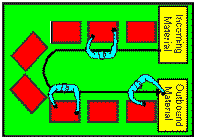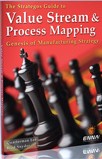|
One Piece Flow refers to the concept of moving one workpiece at a time between
operations within a workcell. At the opposite extreme, we might process an entire batch or lot
at each operation before moving it to the next operation.
This idea has many benefits. It keeps WIP at the lowest possible level. It encourages work
balance, better quality and a host of internal improvements.
We often hear One Piece Flow pronounced as an absolute must for any workcell. Like the search
for the Holy Grail it is taken as a moral imperative. At Strategos, we find it more helpful to
think of this question as the "Transfer Batch" or "Internal Lot size." The issue is: "What
Internal Lot Size will help the cell meet its performance goals."
To approach engineering design using slogans, edicts, or other grand pronouncements is
a dangerous business. Yet many teachers, consultants and practitioners do it. Here are some of
the more common edicts:
-
Inventory is evil and must be eliminated regardless of all other
considerations.
-
The only relevant measure of work-cell performance is throughput
time.
-
Machine utilization is of no consequence and should be ignored.
-
Work-cells must have a straight-through flow for all products.
-
Work-cells must have one-piece flow.
-
Low-tech, manual machine tools are superior to high-tech NC equipment.
Performance goals may vary from one cell or factory to the next. For
some, Quality is the foremost measure of performance. For others, delivery speed and customer
response dominates. For others, labor efficiency is foremost. Where equipment is expensive and
capital scarce, equipment utilization may play a role, although it is often overrated..
|
 The
question of Internal Lot Size is just one of many decisions that specify the workcell design.
Every engineering design is a series of decisions, made in a logical sequence and often
interdependent. For more on this, see our page on Rationalized Workcell Design. The
question of Internal Lot Size is just one of many decisions that specify the workcell design.
Every engineering design is a series of decisions, made in a logical sequence and often
interdependent. For more on this, see our page on Rationalized Workcell Design.
One Piece Flow is an ideal that engineers should strive for. But, it simply does not work
when the transfer time begins to approach the work time. Nor does it work with certain processes
such as shot blasting.
When a cell must address a wide product variety with varied routes, work times, and setup
times, One Piece Flow is also counterproductive. This often occurs in jobbing-type machine shops
or sheet metal shops.
In situations such as those mentioned above, small-batch flow can be a good answer. For
example, the lot size required by a customer might be 100 units of product. This is the
"External Lot Size." The optimum "Internal Lot Size" or "Transfer Batch" might be 10 units.
In operation, the first operation in the cell makes 10 units of the 100 and passes the 10
units to the second operation. The first operation then makes 10 more units and passes them
along. This continues until the External Lot of 100 is complete.
The best workcells are engineered designs which address both the technical and human issues.
Learn more...
For Examples of Inappropriate Use of One Piece Flow, Click Below
|





